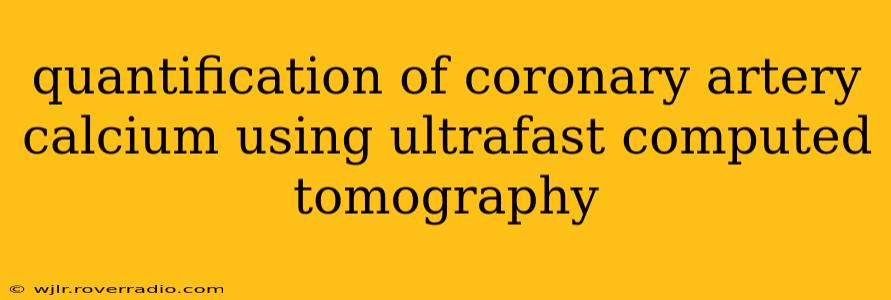Coronary artery calcium (CAC) scoring via ultrafast computed tomography (CT) is a non-invasive imaging technique providing crucial insights into a patient's cardiovascular risk. This advanced imaging modality allows for precise quantification of calcium deposits within the coronary arteries, offering a powerful tool for risk stratification and guiding clinical decision-making. This article delves into the process, benefits, and limitations of CAC quantification using ultrafast CT.
What is Coronary Artery Calcium (CAC) Scoring?
CAC scoring measures the amount of calcium buildup in the coronary arteries. Calcium deposits are a marker of atherosclerosis, a process where plaque builds up inside the arteries, narrowing them and restricting blood flow. The presence and extent of CAC indicate the presence and severity of atherosclerosis, reflecting a patient's overall cardiovascular risk. Higher CAC scores correlate with a significantly increased risk of future cardiovascular events, such as heart attack and stroke.
How is CAC Quantified Using Ultrafast CT?
Ultrafast CT scanners, also known as electron-beam CT (EBCT) or multislice CT (MSCT), acquire images incredibly rapidly, minimizing motion artifacts and allowing for high-resolution visualization of the coronary arteries. During a CAC scan, the patient lies on a table that moves through the CT scanner. A contrast agent isn't needed for CAC scoring, which simplifies the procedure and avoids the potential risks associated with contrast. The acquired images are then processed using specialized software that automatically quantifies the amount of calcium present in each coronary artery. The results are usually expressed as a CAC score, often using the Agatston score, which considers both the amount and density of calcium.
What are the Benefits of CAC Quantification with Ultrafast CT?
- Early Detection of Atherosclerosis: CAC scoring can detect early stages of atherosclerosis, even before symptoms appear. This allows for timely intervention and lifestyle modifications to reduce future cardiovascular risk.
- Risk Stratification: CAC scores provide a powerful tool for risk stratification, supplementing traditional risk factors such as age, blood pressure, cholesterol levels, and smoking status.
- Improved Risk Prediction: CAC scoring significantly improves risk prediction, especially in individuals with intermediate risk profiles. It helps clinicians refine risk assessment and personalize treatment plans.
- Non-invasive Procedure: The procedure is non-invasive, painless, and requires minimal preparation, making it suitable for a wide range of patients.
- Rapid Results: The imaging and quantification process is relatively quick, with results often available within minutes to hours.
What are the Limitations of CAC Quantification with Ultrafast CT?
- Radiation Exposure: While the radiation dose is generally low and comparable to other CT scans, radiation exposure remains a consideration, especially in younger individuals or those requiring repeated scans.
- Cost: CAC scoring using ultrafast CT can be relatively expensive compared to other risk assessment methods.
- Limited Information on Plaque Composition: CAC scoring primarily focuses on calcium, providing limited information about other components of atherosclerotic plaque, such as lipids and inflammation.
- Not Suitable for Everyone: Individuals with severe claustrophobia or significant cardiac arrhythmias may not be suitable candidates for CAC scoring with CT.
What is the Agatston Score?
The Agatston score is the most commonly used method for quantifying CAC. It assigns a numerical value to the calcium deposits based on their size, number, and density. A higher Agatston score indicates a greater amount of calcium and a higher risk of cardiovascular events. A score of zero indicates no detectable calcium.
What Does a High CAC Score Mean?
A high CAC score suggests a significant burden of atherosclerosis, indicating an increased risk of future cardiovascular events. However, it's crucial to remember that CAC is just one factor to consider when assessing cardiovascular risk. Clinicians must consider other risk factors and clinical information to create a comprehensive risk profile and determine the appropriate management strategy.
How Often Should I Get a CAC Scan?
The frequency of CAC scans is dependent on several factors, including individual risk profile, family history, and clinical judgment. There isn't a universally accepted recommendation for routine CAC screening in the general population. The decision to perform a CAC scan is typically made on a case-by-case basis, often in individuals with intermediate risk profiles to better stratify their cardiovascular risk.
Does a CAC Scan Replace Other Cardiovascular Risk Assessments?
No, a CAC scan does not replace other conventional methods of cardiovascular risk assessment. It is a valuable supplementary tool that provides additional information and aids in refining risk stratification. It should be used in conjunction with traditional risk factors, lifestyle assessment, and clinical judgment to create a personalized cardiovascular risk profile and guide preventative strategies.
This information is for educational purposes only and should not be considered medical advice. Consult with a healthcare professional for any concerns about your cardiovascular health.
